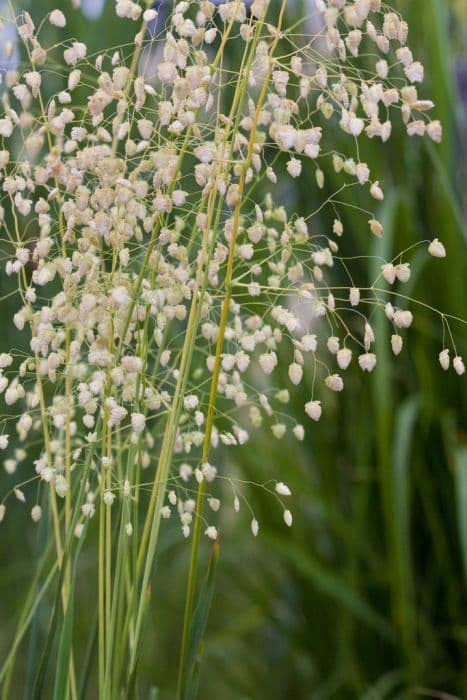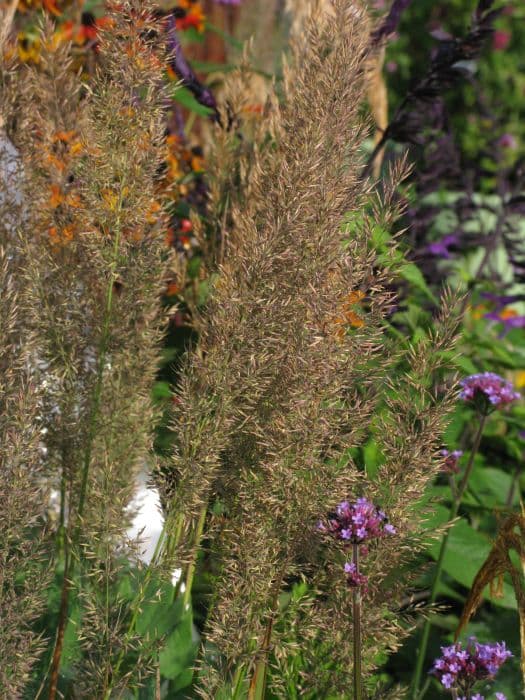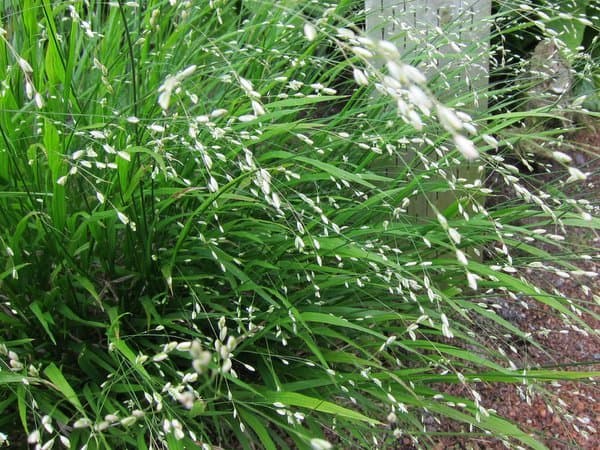Blue Fescue Festuca glauca 'Blaufuchs'

ABOUT
The plant known as 'Blaufuchs', or more commonly as blue fescue, is a striking ornamental grass that is admired for its unique coloration and texture. The foliage of blue fescue is its most striking feature, with its fine, needle-like leaves that create a dense tuft. These leaves have a glaucous, silvery-blue hue that can add a cool tone to any garden setting, making it stand out among greener plants. The plant forms a rounded, cushion-like mound, presenting a tidy and compact shape that looks equally at home in rock gardens or as an edging plant. It provides a beautiful contrast when used alongside plants with darker foliage or brighter flowers. The blue fescue's foliage remains attractive throughout the year, providing a continuous splash of color even in winter. In the warmer months, blue fescue may also produce delicate, feathery flower stalks that rise above the leaves, adding a touch of elegance and vertical interest to the plant's overall appearance. Overall, the aesthetic of the 'Blaufuchs' blue fescue is one of enduring grace, with colors and textures that serve a variety of landscape uses, from focal points to complementary roles in a diverse garden design.
About this plant
 Names
NamesFamily
Poaceae
Synonyms
Blue Fescue, Blue Fox, Blue Mountain Grass, Grey Fescue
Common names
Festuca glauca 'Blaufuchs'.
 Toxicity
ToxicityTo humans
Blue fescue (Festuca glauca 'Blaufuchs') is not known to be toxic to humans. It is generally considered safe around people, and there are no common symptoms of poisoning from this plant, as it is not typically ingested. Therefore, there should be no expected consequences from ingesting parts of the blue fescue.
To pets
Blue fescue is also not known to be toxic to pets. This ornamental grass is typically safe for pets to be around, and ingestion should not lead to poisoning. Hence, there are no specific symptoms or consequences associated with pets ingesting blue fescue.
 Characteristics
CharacteristicsLife cycle
Perennials
Foliage type
Evergreen
Color of leaves
Blue
Height
1 foot (30 cm)
Spread
1 foot (30 cm)
Plant type
Herb
Hardiness zones
4
Native area
Europe
Benefits
 General Benefits
General Benefits- Drought Tolerance: Festuca glauca 'Blaufuchs', commonly known as Blue Fescue, is highly drought-resistant once established, requiring minimal watering.
- Low Maintenance: Blue Fescue demands very little care in terms of fertilizing, mowing, or pruning, making it ideal for low-maintenance landscapes.
- Tolerance of Poor Soils: It grows well in a variety of soil types, even in poor or rocky soils, where other plants might struggle.
- Erosion Control: Due to its dense root system, Blue Fescue is effective in stabilizing soil and preventing erosion on slopes.
- Aesthetic Appeal: Its striking blue-grey foliage and tidy clumping habit make it a popular ornamental grass for gardens and decorative borders.
- Cold Hardy: Blue Fescue is able to withstand cold temperatures and is suitable for growing in a wide range of climates.
- Pest Resistance: It is generally resistant to pests and diseases, reducing the need for chemical treatments.
- Attracts Wildlife: The grass can attract birds and butterflies, which can add life and interest to a garden setting.
- Year-Round Interest: Even in winter, the grass can maintain its color and form, providing visual interest throughout the year.
- Versatile Landscape Use: Blue Fescue is suitable for use in rock gardens, as groundcover, or in container plantings, offering versatility in landscape design.
 Medical Properties
Medical PropertiesThis plant is not used for medical purposes.
 Air-purifying Qualities
Air-purifying QualitiesThis plant is not specifically known for air purifying qualities.
 Other Uses
Other Uses- Erosion Control: 'Blue Fescue' can be used in landscaping to stabilize soil and prevent erosion, particularly on slopes and banks due to its dense, mat-forming growth habit.
- Crafts and Floristry: Dried 'Blue Fescue' grass can be incorporated into floral arrangements, wreaths, or craft projects for its distinctive blue hue and texture.
- Decorative Mulch: Because of its compact size and color, 'Blue Fescue' can be used as a living mulch to add visual interest to garden beds and suppress weeds.
- Garden Art Contrast: 'Blue Fescue' can be situated strategically within a garden to contrast with bold-colored sculptures or garden art, enhancing the aesthetic appeal of outdoor spaces.
- Sensory Gardens: The fine, hair-like foliage of 'Blue Fescue' can serve as a tactile element in gardens designed for sensory experiences.
- Edging for Garden Pathways: 'Blue Fescue' works well as a border along garden paths, providing a soft yet structural edge to guide visitors through the landscape.
- Urban Green Roofs: Its tolerance for drought makes 'Blue Fescue' an appropriate choice for green roofs in urban settings, where it can help insulate buildings and reduce heat absorption.
- Photography and Painting: The striking blue color and fine texture of 'Blue Fescue' offer a photogenic subject for photographers and a pleasing detail for painters capturing garden landscapes.
- Model Landscaping: Miniature and model landscapes, such as those for model trains or architectural presentations, can benefit from the scale-appropriate size and texture of 'Blue Fescue'.
- Mindfulness Spaces: Planting 'Blue Fescue' in a quiet corner of the garden provides a soothing, monochromatic space for meditation or mindfulness exercises.
Interesting Facts
 Feng Shui
Feng ShuiThe Blue Fescue is not used in Feng Shui practice.
 Zodiac Sign Compitability
Zodiac Sign CompitabilityThe Blue Fescue is not used in astrology practice.
 Plant Symbolism
Plant Symbolism- Resilience: The Fescue grass, with its ability to thrive in poor soil conditions and resist drought, symbolizes resilience and robustness in the face of adversity.
- Independence: It largely takes care of itself once established, representing independence and self-sufficiency.
- Perseverance: This plant's capacity to withstand tough environments and its persistence in growth embody the spirit of perseverance.
- Endurance: The hardiness of Festuca glauca 'Blaufuchs' is a testament to enduring through challenges and symbolizes long-lasting strength and stamina.
 Water
WaterBlue fescue should be watered moderately, as it is tolerant of dry conditions once established. During the first growing season, ensure consistent moisture to help establish a strong root system; this may require watering once or twice a week depending on climate conditions. After establishment, reduce frequency, watering only when the top inch of soil feels dry. Typically, this may mean providing the plant with about 1 inch of water every couple of weeks during the growing season. Overwatering should be avoided as blue fescue prefers drier conditions.
 Light
LightBlue fescue thrives best in full sun to partial shade. It requires at least 6 to 8 hours of direct sunlight daily to maintain its compact form and steel blue color. An optimal spot would be an area that receives unfiltered sunlight throughout the day, though a little afternoon shade can be beneficial in hotter climates.
 Temperature
TemperatureBlue fescue is hardy and can withstand a range of temperatures. It typically survives winter temperatures down to -20°F and is suitable for growing in USDA hardiness zones 4 through 8. The ideal temperature range for growing blue fescue is between 60°F and 75°F, where it can grow most vigorously.
 Pruning
PruningPrune blue fescue to remove dead foliage and maintain its neat appearance. The best time to do this is in early spring before new growth starts. Pruning is typically needed once a year; cut the plant back by about two-thirds to help stimulate fresh, new growth and maintain its rounded shape.
 Cleaning
CleaningAs needed
 Soil
SoilBlue Fescue thrives in well-draining soil with a slightly acidic to neutral pH between 5.5 and 7.0. A mixture of garden soil, coarse sand, and peat or compost will create an ideal environment for this ornamental grass. Maintaining a loose soil structure allows roots to establish without becoming waterlogged.
 Repotting
RepottingBlue Fescue is typically a low-maintenance plant that doesn't require frequent repotting. It can be repotted every 2-3 years to refresh the soil. Due to its moderate growth rate, choose a container just slightly larger than the previous one to prevent excess soil moisture.
 Humidity & Misting
Humidity & MistingBlue Fescue tolerates a wide range of humidity levels. However, it prefers lower humidity conditions similar to its native environments. Normal outdoor ambient humidity is generally sufficient for this grass without the need for extra measures.
 Suitable locations
Suitable locationsIndoor
Place Blue Fescue in a bright spot with good air circulation.
Outdoor
Plant Blue Fescue in full sun and well-drained soil.
Hardiness zone
4-8 USDA
 Life cycle
Life cycleBlue fescue 'Blaufuchs' begins its life as a seed, which when sown in well-draining soil and with exposure to sunlight and water, will germinate within 2-3 weeks. The sprouted seeds develop into seedlings and gradually form a clump of fine, needle-like blue-green foliage that is characteristic of blue fescue. Throughout the growing season, particularly in spring and early summer, this perennial grass grows actively and may produce tan to blue-green flower spikes that stand above the foliage. After flowering, the plant sets seed, which can be collected if desired or left to self-sow under suitable conditions. As a perennial, blue fescue 'Blaufuchs' will enter a period of dormancy during the winter months, particularly in colder climates, where the foliage may die back before regrowing from its crown with the return of warmer temperatures in spring. With proper care, including occasional division to maintain vigor, the plant can last several years before it may need to be replaced due to aging or woody growth at the base.
 Propogation
PropogationPropogation time
Spring-Early Summer
Festuca glauca 'Blaufuchs', commonly known as Blue Fescue, is typically propagated by division, which is best done in the early spring or autumn. This method involves carefully digging up the established clump of the grass and gently separating it into smaller sections, ensuring each new piece has a sufficient root system and a few tufts of leaves. These divisions are then planted into a well-draining soil mix, at the same depth they were growing previously. Water the newly planted divisions well to help them establish. It's important to maintain consistent moisture, without overwatering, as the young plants acclimate and begin to grow independently.









